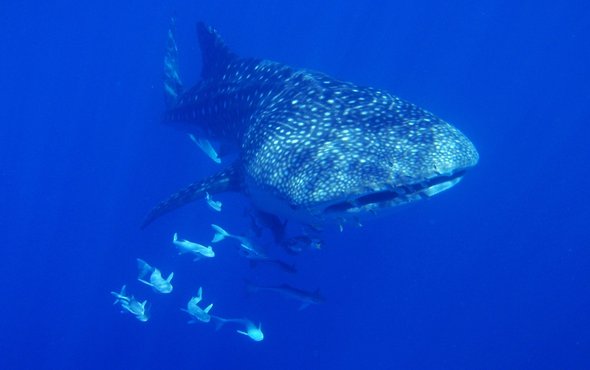(单词翻译:单击)
听力文本
This is Scientific American — 60-Second Science. I'm Annie Sneed.
It's called the whale shark. And, as the name implies, it's huge. In fact, it's the largest living fish in the world. But there's still much unknown about this big animal.
"They're very enigmatic in the sense that they're elusive, very difficult to catch up with." Alistair Dove, an expert on the biology of whale sharks and vice president of research and conservation at Georgia Aquarium.
But citizen scientists are helping Dove and other whale shark experts get a fuller picture of this marine creature. Tourists, residents and professional scientists have documented the fish for an online database, called the Wildbook for Whale Sharks. By taking advantage of each shark's unique pattern of skin spots.
"So the Wildbook architecture was really the brainchild of Zaven Arzoumanian and Jason Holmberg...and they adapted an algorithm that was used by the Hubble telescope for recognizing patterns in star field photographs from astrophotography and realized that the spots on a whale shark are really very much the same idea. That whether we can identify individual whale sharks by their spot patterns. And with the help of whale shark scientists like Brad Normal, who is the lead author on this study, they were able to bring that into a citizen-science format that allowed people to upload photographs and use these powerful computer algorithms to recognize individual whale sharks."

"And at that point, sharks stopped being random animals that you meet in the ocean and they become individuals with stories and histories and futures that are yet to be written. And that's what makes it so seductive as a citizen-science project."
Whale shark watchers simply snap a photo of the skin pattern on one side of the fish—preferably the left side, says Dove. "And then you upload a picture of that animal to the Wildbook Web site, and the people on the back end will...tell you whether that animal has ever been seen anywhere before. And that's very exciting. And it's kind of a win-win prospect. Because if the animal's never been seen before then you've added a new animal to the database and that's exciting. If the animal has been seen before then you get to know its story and know where it's been and when. And that's exciting too. So it's great fun for scientists and it's great fun for tourists alike."
All told, the Wildbook database now has over 5,000 citizen-science contributors, around 30,000 whale shark encounters covering 54 countries, and more than 6,000 individual whale sharks identified. Now in the latest study using that data, researchers report that the number of known sites where whale sharks gather has risen from 13 to 20. "By all working together and putting our data into a common pot...we get a global picture about where whale sharks are and what they're doing." The study is in the journal BioScience.
The new information may lead to better conservation strategies. "The species is listed as endangered on the IUCN Red List, which means that the population is declining, and that's cause for significant concern. So this is a species we should all be paying attention to as a bellwether of what might be expected for big animals that live in the ocean."
Thanks for listening for Scientific American — 60-Second Science. I'm Annie Sneed.
参考译文
这里是科学美国人——60秒科学。我是安妮·斯尼德。
它被称为鲸鲨。顾名思义,它体型巨大。事实上,它是世界上现存最大的鱼类。但是这种大型动物,仍有很多未解之谜。
“它们非常神秘,很难捉到。”鲸鲨生物学专家、乔治亚水族馆研究与保护所副主席阿利斯泰尔·德夫说到。
但是,公民科学家正在帮助德夫和其他鲸鲨专家更全面地了解这种海洋生物。游客、居民和专业科学家将鲸鲨的资料记录在名为“鲸鲨自然手册”的在线数据库中。他们利用每只鲸鲨皮肤斑点的独特图案来进行记录。
“因此,自然手册体系确实是扎文·亚尔佐马尼安和杰森·霍姆伯格的智慧结晶,他们修改了一种算法,哈勃望远镜曾用这种算法从天体摄影的恒星场照片中识别图形,他们意识到,鲸鲨身上的斑点与该图形有异曲同工之妙。他们设想,是否能通过其身上的斑点图案来识别出鲸鲨个体。在该研究作者布拉德·诺马尔等鲸鲨科学家的帮助下,研究人员得以让识别过程成为一种公民科学形式,即允许人们上传照片,并用这些强大的计算机算法来识别个体鲸鲨。”
“在这种情况下,鲸鲨不再是你在海洋中遇到的随机动物,而是成为了拥有有待书写故事、历史和未来的个体。而这正是这项公民科学项目如此迷人的原因。”
德夫表示,鲸鲨观测者只需拍下其身体一侧的皮肤图案,最好是左侧的图案。“然后你将照片上传到‘自然手册’网站,网站后端工作人员会告诉你这只鲸鲨以前是否被目击过。这非常令人兴奋。这是种双赢前景。因为,如果这只鲸鲨以前从未被目击过,那你就在数据库中添加了一只新的个体,这相当激动人心。如果这只鲸鲨以前被目击过,那你就会知道它的故事,会知道它在何时何地被目击过。这同样激动人心。所以,这对科学家来说非常有趣,而对游客来说同样非常有趣。”
自然手册数据库目前共有超过5000名公民科学家贡献者,涵盖54个国家的约3万名鲸鲨遇袭者,以及超过6000只已被确认的鲸鲨个体。在使用这些数据的最新研究中,研究人员报告称,目前已知的鲸鲨聚集地的数量已从13个增加到20个。“通过所有人的共同努力,将所有数据汇集到一个公共的数据库中,我们可以得到一份全球图景,了解鲸鲨在哪里以及它们在做什么。”这项研究结果发表在《生物科学》期刊上。
这些新信息可能会催生更好的保护策略。“鲸鲨已被世界自然保护联盟红色名录列为濒危物种,这意味着该物种的数量正在减少,这引发了极大的担忧。所以,鲸鲨是我们都应该密切关注的物种,我们应该将其视为生活在海洋中的大型动物的领导者。”
谢谢大家收听科学美国人——60秒科学。我是安妮·斯尼德。
译文为可可英语翻译,未经授权请勿转载!
重点讲解
重点讲解:
1. catch up with 捕获;擒获;捉拿到;
He is always fooling around in class, but the teacher will catch up with him some day.
他总是在班上捉弄人,总有一天老师会抓住他的。
2. take advantage of 利用;
I want to take advantage of your lifetime of scholarship.
我希望能够用到您一生的学识。
3. all told 总共;合计;总之;
All told there were 104 people on the payroll.
在职的总共有 104 人。
4. pay attention to 关心;注意;
In doing our work, we must pay attention to ways and means.
做工作应注意方式方法。


